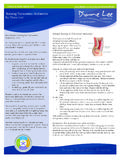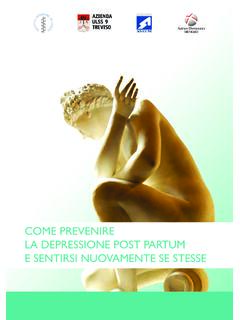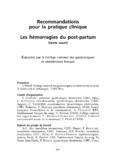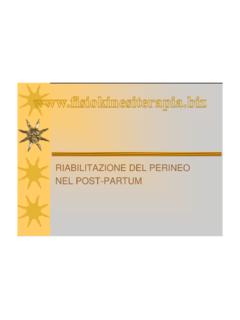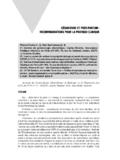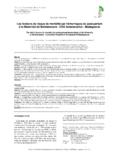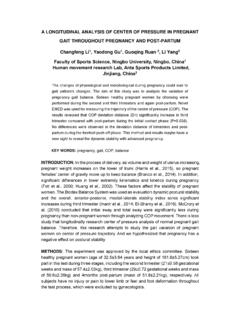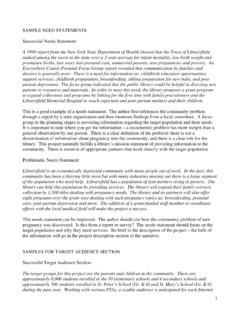Transcription of Diastasis Rectus Abdominis & Postpartum Health ...
1 Diastasis Rectus Abdominis & Postpartum Health Consideration for Exercise Training Written by Diane Lee BSR, FCAMT, CGIMS Physiotherapist The following article is adapted from a larger publication Stability, Continence and Breathing - The role of fascia in both function and dysfunction and the potential consequences following pregnancy and delivery published in the Journal of Bodywork and Movement Therapies 12, 333-348 by Lee D G BSR, FCAMT, CGIMS , Lee L J BSc, BSc (PT), FCAMT, CGIMS, McLaughlin L BHScPT, DScPT, FCAMT, CMAG. The article was based on a workshop presented at the First Fascial Research Conference at Harvard Medical School in Boston MA in October 2007.
2 Introduction Pregnancy-related pelvic girdle pain (PRPGP) has a prevalence of approximately 45% during pregnancy (Wu et al 2004) and 20 25 % in the early Postpartum period (Ostgaard et al 1991, Albert et al 2002, Wu et al 2004). Most women will become pain free in the first 12 weeks after delivery however; 5-7% will not (Ostgaard & Andersson 1992). In a large Postpartum study of prevalence for urinary incontinence (UI), Wilson et al (2002) found that 45% of women experienced UI at 7 years Postpartum and that 27% who were initially incontinent in the early Postpartum period regained their continence while 31% who were continent became incontinent.
3 Clearly for some women, something happens during pregnancy and delivery that impacts the function of the abdominal canister (Fig. 1) either immediately, or over time. The abdominal canister is a functional and anatomical construct based on the components of the abdominal cavity that synergistically work together. It contains the abdominal and pelvic viscera and is bounded by many structures including: the diaphragm including its cura and by extension the psoas muscle whose fascia intimately blends with that of the pelvic floor and the obturator internus muscle, the deep abdominal wall including transversus Abdominis and its associated fascial connections anteriorly and posteriorly, the deep fibres of multifidus, the intercostals, the thoracolumbar vertebral column (T6 -12 and associated ribs L5) and osseus components of the pelvic girdle (innominates, sacrum and femora).
4 The lumbopelvic canister contains 85 joints all of which require stabilization during functional tasks. Optimal strategies for function and performance will ensure controlled mobility, preservation of continence and organ support and respiration. Current evidence suggests that the muscles and fascia of the lumbopelvic region play a significant role in musculoskeletal function as well as continence and respiration and the combined prevalence of lumbopelvic pain, incontinence and breathing disorders is slowly being understood (Pool-Goudzwaard et al 2005, Smith et al 2007a).
5 It is also clear that synergistic function of all trunk muscles is required for loads to be transferred effectively through the lumbopelvic region during multiple tasks of varying load, predictability and perceived threat (Hodges & Cholewicki 2007). Optimal strategies for transferring loads will balance control of movement while maintaining optimal joint axes, maintain sufficient intra-abdominal pressure without compromising the organs (preserve continence, prevent prolapse or herniation) and support efficient respiration.
6 Non-optimal strategies for posture, movement and/or breathing create failed load transfer that can lead to pain, incontinence and/or breathing disorders. The Clinical Puzzle (Lee & Lee 2007) is a graphic used for clinical reasoning in The Integrated Systems Model. The outer ring represents the strategies an individual uses for function and performance of any task assessed. Optimal strategies for function and performance depend on the integrity of all pieces within the circle. This evidenced-based model considers the role of, and interplay between, psychosocial and systemic physiological factors (the person in the middle of the puzzle), the articular system, the neural system, the myofascial system, and the visceral system.
7 Reproduced with permission from Lee & Lee Individual or combined impairments in multiple systems including the articular, neural, myofascial and/or visceral can lead to non-optimal strategies during single or multiple tasks. Biomechanical aspects of the myofascial piece of the clinical puzzle as it pertains to the abdominal canister during pregnancy and delivery is the focus of this article. The reader is referred to the original source (Lee et al 2008) for the full paper. The Anterior Abdominal Fascia & Pregnancy It is well established that transversus Abdominis plays a crucial role in optimal function of the lumbopelvis and that one mechanism by which this muscle contributes to intersegmental (Hodges et al 2003) and intrapelvic (Richardson et al 2002) stiffness is through fascial tension.
8 Diastasis Rectus Abdominis (DRA) has the potential to disrupt this mechanism and is a common Postpartum occurrence (Boissonnault & Blaschak 1988, Spitznagle et al 2007). Universally, the most obvious visible change during pregnancy is the expansion of the abdominal wall and while most abdomens accommodate this stretch very well, others are damaged extensively. Diastasis Rectus Abdominis - This patient has a large Diastasis Rectus Abdominis measuring cm wide just above the umbilicus with obvious damage to her skin and superficial fascia.
9 One structure particularly affected by the expansion of the abdomen is the linea alba, the complex connective tissue (Axer et al 2001) which connects the left and right abdominal muscles. The width of the linea alba is known as the inter-recti distance and normally varies along its length from the xyphoid to the pubic symphysis. According to Beer et al (2009), in women between the age of 20 & 45, them width of the normal linea alba is highly variable. The mean width measures found via ultrasound imaging in this study of 150 nulliparous women were 7mm 5 at xyphoid, 13mm 7 3cm above Umbilicus, and8mm 6 2cm below Umbilicus.
10 This width can be reliably measured with ultrasound imaging (Coldron et al 2007, Lee D 2008 unpublished data). A DRA is commonly diagnosed when the width exceeds these amounts. There is little research on this condition; Boissonnault & Blaschak (1988) found that 27% of women have a DRA in the second trimester and 66% in the third trimester of pregnancy. 53% of these women continued to have a DRA immediately Postpartum and 36% remained abnormally wide at 5-7 weeks Postpartum . Coldron et al (2008) measured the inter-recti distance from 1 day to 1 year Postpartum and note that the distance decreased markedly from day 1 to 8 weeks, and that without any intervention ( exercise training or other physiotherapy) there was no further closure at the end of the first year.
